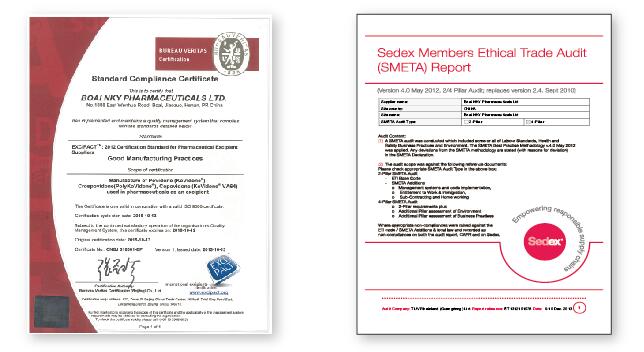- Product Details
Keywords
- 25086-89-9 manufacturer
- Copovidone PVP VA64 in China
- Copovidone
Quick Details
- ProName: Copovidone PVP VA64 in China 25086-89-...
- CasNo: 25086-89-9
- Molecular Formula: (C6H9NO)n+(C4H6O2)m
- Appearance: White or off white powder
- Application: Pharmaceutical & Health Care
- DeliveryTime: 15-20days
- PackAge: net 20kg fibre drum
- ProductionCapacity: 200 Metric Ton/Month
- Purity: 95%
- Transportation: By sea or by air
- LimitNum: 0 Metric Ton
Superiority

| Safety Information |
| Hazard Codes | Xi,F |
| Risk Statements | 10-36/37/38-67-36-11-22 |
| Safety Statements | 22-24/25-36/37/39-26-16 |
| RIDADR | UN 1987 3/PG 2 |
| WGK Germany | 1 |
| RTECS | AH3539000 |
| HazardClass | 3 |
| PackingGroup | II |
| HS Code | 29349990 |
Chemical Properties white powder
Chemical Properties Copovidone is a white to yellowish-white amorphous powder. It is typically spray-dried with a relatively fine particle size. It has a slight odor and a faint taste.
Uses Poly(1-vinylpyrrolidone-co-vinyl acetate)
Production Methods Copovidone is manufactured by free-radical polymerization of vinylpyrrolidone and vinyl acetate in a ratio of 6 : 4. The synthesis is conducted in an organic solvent owing to the insolubility of vinyl acetate in water.
Pharmaceutical Applications Copovidone is used as a tablet binder, a film-former, and as part of the matrix material used in controlled-release formulations. In tableting, copovidone can be used as a binder for direct compression and as a binder in wet granulation. Copovidone is often added to coating solutions as a film-forming agent. It provides good adhesion, elasticity, and hardness, and can be used as a moisture barrier.
Safety Copovidone is used widely in pharmaceutical formulations and is generally regarded as nontoxic. However, it is moderately toxic by ingestion, producing gastric disturbances. It has no irritating or sensitizing effects on the skin. A study was conducted to look at the carcinogenicity and chronic toxicity of copovidone (Kollidon VA 64) in Wistar rats and Beagle dogs. The results of these studies demonstrated the absence of any significant toxicological findings of high dietary levels of copodivone in rats and dogs, resulting in noobserved- adverse-effect levels of 2800 mg/kg body-weight/day in rats and 2500 mg/kg body-weight/day in dogs, the highest doses tested.
LD50 (rat, oral): >0.63 g/kg
Details

KoVidone® VA64
Product name KoVidone® VA64 Copovidone
USP/EP name Copovidone, Copovidonum
INCI/CTFA VP/VA copolymer 60/40
CAS NO. 25086-89-9
K value 25.2-30.8 (Copovidone 28), 27.0-33.0 (Copovidone 30)
Properties Hygroscopic capacity lower than KoVidone® K30; Soluble in water, alcohol and many other organic solvents; Glass transition temperature(Tg) lower than KoVidone® K30; Forms transparent, water removable films.
The content of vinyl acetate 35.3-41.0%
Applications
KoVidone® VA64 possesses excellent powder and film properties for broad application in the pharmaceutical field:
· Water soluble tablet binder; suitable for wet or dry granulation and direct compression processes, improves particle compressibility.
· Film-former; permeable film coating for tablet and sugar coatings to protect against splitting, decrease moisture sensitivity and provide good film adhesiveness, elasticity, and hardness.
· Porogenic agent; for use in taste-masking and component of the matrix material used in controlled-release formulation.
· Solubilizing agents; for solid dispersion processes to enhancing bioavailability and improve drug solubility. For use in both Hot Melt Extrusion and Spray Solvent Drying

The addition of KoVidone® VA64 to HPMC film coating solutions can effectively reduce the viscosity of the HPMC solution while enhancing resultant film characteristics by improving film formation, flexibility and gloss.
Nimodipine- KoVidone® VA64 solid dispersion HME process
Due to its lower glass transition temperature Tg, KoVidone® VA64 is especially suited for developing solid dispersion drug systems via hot melt extrusion processing.
Hot melt extrusion (HME) technology is a new technique to prepare pharmaceutical dosage forms. HME shows unique advantages and is used to: improve the dissolution rate of extremely poorly soluble drugs..
HME uses no solvent in the production process, the drug is hot melt extruded with a suitable polymer carrier (Kovidone® VA64). The extrusion process converts crystalline drugs to their amorphous form (Solid Dispersion) that helps to improve both drug solubility and bioavailability and increase the stability of the finished dosage form.
Solid Dispersions can also be produced via Spray Solvent Drying whereby the Kovidone and poory soluble active are dissolved in a suitable solvent and spray dried. The resulting Solid Dispersion is similar to that achieved with HME.





